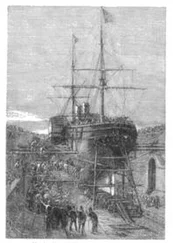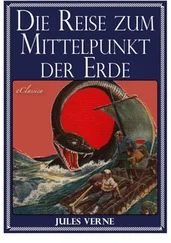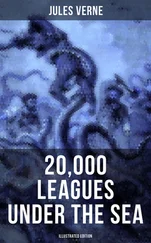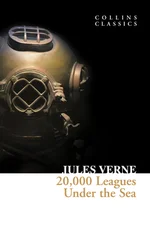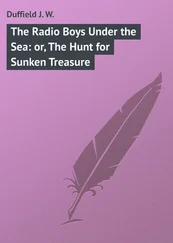Jules Verne - Twenty Thousand Leagues Under the Sea
Здесь есть возможность читать онлайн «Jules Verne - Twenty Thousand Leagues Under the Sea» — ознакомительный отрывок электронной книги совершенно бесплатно, а после прочтения отрывка купить полную версию. В некоторых случаях можно слушать аудио, скачать через торрент в формате fb2 и присутствует краткое содержание. Жанр: sf_writing, на английском языке. Описание произведения, (предисловие) а так же отзывы посетителей доступны на портале библиотеки ЛибКат.
- Название:Twenty Thousand Leagues Under the Sea
- Автор:
- Жанр:
- Год:неизвестен
- ISBN:нет данных
- Рейтинг книги:5 / 5. Голосов: 2
-
Избранное:Добавить в избранное
- Отзывы:
-
Ваша оценка:
- 100
- 1
- 2
- 3
- 4
- 5
Twenty Thousand Leagues Under the Sea: краткое содержание, описание и аннотация
Предлагаем к чтению аннотацию, описание, краткое содержание или предисловие (зависит от того, что написал сам автор книги «Twenty Thousand Leagues Under the Sea»). Если вы не нашли необходимую информацию о книге — напишите в комментариях, мы постараемся отыскать её.
Twenty Thousand Leagues Under the Sea — читать онлайн ознакомительный отрывок
Ниже представлен текст книги, разбитый по страницам. Система сохранения места последней прочитанной страницы, позволяет с удобством читать онлайн бесплатно книгу «Twenty Thousand Leagues Under the Sea», без необходимости каждый раз заново искать на чём Вы остановились. Поставьте закладку, и сможете в любой момент перейти на страницу, на которой закончили чтение.
Интервал:
Закладка:
"Vanikoro."
The effect was magical! It was the name of the islands on which La Perouse had been lost! I rose suddenly.
"The Nautilus has brought us to Vanikoro?" I asked.
"Yes, professor," said the captain.
"And I can visit the celebrated islands where the Boussole and the Astrolabe struck?"
"If you like, professor."
"When shall we be there?"
"We are there now."
Followed by Captain Nemo, I went up on to the platform, and greedily scanned the horizon.
To the N.E. two volcanic islands emerged, of unequal size, surrounded by a coral reef that measured forty miles in circumference.
We were close to Vanikoro, really the one to which Dumont d'Urville gave the name of Isle de la Recherche, and exactly facing the little harbor of Vanou, situated in 16 4' south latitude, and 164 32' east longitude. The earth seemed covered with verdure from the shore to the summits in the interior, that were crowned by Mount Kapogo, 476 feet high. The Nautilus, having passed the outer belt of rocks by a narrow strait, found itself among breakers where the sea was from thirty to forty fathoms deep. Under the verdant shade of some mangroves I perceived some savages, who appeared greatly surprised at our approach. In the long black body, moving between wind and water, did they not see some formidable cetacean that they regarded with suspicion?
Just then Captain Nemo asked me what I knew about the wreck of La Perouse.
"Only what everyone knows, captain," I replied.
"And could you tell me what everyone knows about it?" he inquired ironically.
"Easily."
I related to him all that the last works of Dumont d'Urville had made known-works from which the following is a brief account.
La Perouse, and his second, Captain de Langle, were sent by Louis XVI, in 1785, on a voyage of circumnavigation. They embarked in the corvettes the Boussole and the Astrolabe, neither of which were again heard of. In 1791 the French government, justly uneasy as to the fate of these two sloops, manned two large merchantmen, the Recherche and the Esperance, which left Brest the 28th of September, under the command of Bruni d'Entrecasteaux.
Two months after, they learned from Bowen, commander of the Albemarle, that the debris of shipwrecked vessels had been seen on the coasts of New Georgia. But D'Entrecasteaux, ignoring this communication-rather uncertain besides-directed his course toward the Admiralty Isles, mentioned in a report of Captain Hunter's as being the place where La Perouse was wrecked.
They sought in vain. The Esperance and the Recherche passed before Vanikoro without stopping there, and in fact this voyage was most disastrous, as it cost D'Entrecasteaux his life, and those of two of his lieutenants, besides several of his crew.
Captain Dillon, a shrewd old Pacific sailor, was the first to find unmistakable traces of the wrecks. On the 15th of May, 1824, his vessel, the St. Patrick, passed close to Tikopia, one of the New Hebrides. There a Lascar came alongside in a canoe, sold him the handle of a sword in silver, that bore the print of characters engraved on the hilt. The Lascar pretended that six years before, during a stay at Vanikoro, he had seen two Europeans that belonged to some vessels that had run aground on the reefs some years ago.
Dillon guessed that he meant La Perouse, whose disappearance had troubled the whole world. He tried to get on to Vanikoro, where according to the Lascar he would find numerous debris of the wreck, but winds and tide prevented him.
Dillon returned to Calcutta. There he interested the Asiatic Society and the Indian Company in his discovery. A vessel, to which was given the name of the Recherche, was put at his disposal, and he set out, January 23, 1827, accompanied by a French agent.
The Recherche, after touching at several points in the Pacific, cast anchor before Vanikoro, July 7, 1827, in this same harbor of Vanou where the Nautilus was at this time.
There it collected numerous relics of the wreck-iron utensils, anchors, pulley-strops, swivel-guns, an eighteen-pound shot, fragments of astronomical instruments, a piece of crown-work, and a bronze clock, bearing this inscription: "Bazin m'a fait," the mark of the foundry of the arsenal at Brest about 1785. There could be no further doubt.
Dillon, having made all inquiries, stayed in the unlucky place till October. Then he quitted Vanikoro, and directed his course toward New Zealand; put into Calcutta, April 7, 1828, and returned to France, where he was warmly welcomed by Charles X.
But at the same time, without knowing Dillon's movements, Dumont d'Urville had already set out to find the scene of the wreck. And they had learned from a whaler that some medals and a cross of St. Louis had been found in the hands of some savages of Louisiade and New Caledonia. Dumont d'Urville, commander of the Astrolabe, had then sailed, and two months after Dillon had left Vanikoro, he put into Hobart Town. There he learned the results of Dillon's inquiries, and found that a certain James Hobbs, second lieutenant of the Union, of Calcutta, after landing on an island situated 8 18' south latitude, and 156 30' east longitude, had seen some iron bars and red stuffs used by the natives of these parts. Dumont d'Urville, much perplexed, and not knowing how to credit the reports of low-class journals, decided to follow Dillon's track.
On the 10th of February, 1828, the Astrolabe appeared off Tikopia, and D'Urville took as guide and interpreter a deserter found on the island; made his way to Vanikoro, sighted it on the 12th inst., lay among the reefs until the 14th, and not until the 20th did he cast anchor within the barrier in the harbor of Vanou.
On the 23d, several officers went round the island, and brought back some unimportant trifles. The natives, adopting a system of denials and evasions, refused to take them to the unlucky place. This ambiguous conduct led them to believe that the natives had ill-treated the castaways, and indeed they seemed to fear that Dumont d'Urville had come to avenge La Perouse and his unfortunate crew.
However, on the 26th, appeased by some presents, and understanding that they had no reprisals to fear, they led M. Jacquireot to the scene of the wreck.
There, in three or four fathoms of water, between the reefs of Pacou and Vanou, lay anchors, cannons, pigs of lead and iron, imbedded in the limy concretions. The large boat and the whaler belonging to the Astrolabe were sent to this place, and, not without some difficulty, their crews hauled up an anchor weighing 1,800 pounds, a brass gun, some pigs of iron, and two copper swivel-guns.
Dumont d'Urville, questioning the natives, learned, too, that La Perouse, after losing both his vessels on the reefs of this island, had constructed a smaller boat, only to be lost a second time. Where? No one knew.
But the French government, fearing that Dumont d'Urville was not acquainted with Dillon's movements, had sent the sloop Bayonnaise, commanded by Legoarant de Tromelin, to Vanikoro, which had been stationed on the west coast of America. The Bayonnaise cast her anchor before Vanikoro some months after the departure of the Astrolabe, but found no new document; but stated that the savages had respected the monument to La Perouse. That is the substance of what I told to Captain Nemo.
"So," he said, "no one knows now where the third vessel perished that was constructed by the castaways on the island of Vanikoro?"
"No one knows."
Captain Nemo said nothing, but signed to me to follow him into the large saloon. The Nautilus sank several yards below the waves, and the panels were opened.
I hastened to the aperture, and under the crustations of coral, covered with fungi, syphonules, alcyons, madrepores, through myriads of charming fish-girelles, glyphisidri, pompherides, diacopes, and holocentres-I recognized certain debris that the drags had not been able to tear up: iron stirrups, anchors, cannons, bullets, capstan-fittings, the stem of a ship-all objects clearly proving the wreck of some vessel, and now carpeted with living flowers.
Читать дальшеИнтервал:
Закладка:
Похожие книги на «Twenty Thousand Leagues Under the Sea»
Представляем Вашему вниманию похожие книги на «Twenty Thousand Leagues Under the Sea» списком для выбора. Мы отобрали схожую по названию и смыслу литературу в надежде предоставить читателям больше вариантов отыскать новые, интересные, ещё непрочитанные произведения.
Обсуждение, отзывы о книге «Twenty Thousand Leagues Under the Sea» и просто собственные мнения читателей. Оставьте ваши комментарии, напишите, что Вы думаете о произведении, его смысле или главных героях. Укажите что конкретно понравилось, а что нет, и почему Вы так считаете.

